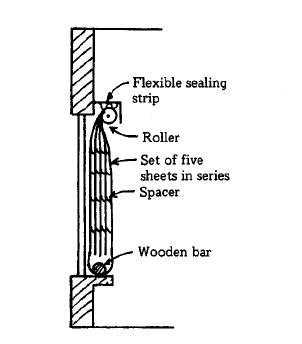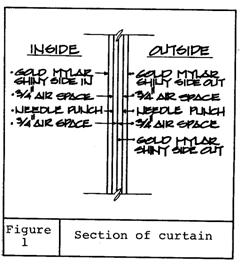
Search
The Renewable Energy site for Do-It-Yourselfers
The Quest for an
R15 Thermal Window Shade
|
Back in the late 70's and
80's there was an effort to develop very good insulating window shades.
These shades used multiple layers of reflective plastic films to achieve
very high R values. Some of the shades were reported to have R
values in the R15 area, making them as good as a typical insulated wall,
and cutting window heat loss by a factor of 7 over a conventional double
glazed window.
With the end of the oil
crisis in the 80's, work on these shades stopped, and (as far as I
know) the commercial products that were coming out went away.
I think that this is a very
promising area for development, and well within the capability of many
backyard inventors and experimenters. It is a promising area for
both DIY and commercial development.
Heat loss from windows can be
as high as 50% of the total house heat loss (depending on the house
design), so cutting this to near zero with these shades could be a
significant reduction in fuel costs and greenhouse gas emissions.
|
|
These shades could improve the performance of passive solar homes by greatly
reducing the night heat loss through large, south facing windows. They
could also allow larger windows in super insulated homes without incurring
additional heat loss penalty.
While inside shutters made from rigid
foam board insulation can offer similar R values, these shades made from layers
of film have the advantage that they rollup out of the way within the existing
window frame. This eliminates the need to find a place to stow large and
awkward foam board sheets, and makes deploying the shades much easier.
I've assembled some material below
that describes some of the designs, and provides some early test data.
These might help you get started on a similar project.
If you do some work on these high R
value thermal shades, or have information to add, please let me know --
Gary...
Excerpt From "Thermal Shades and
Shutters"
| This excerpt from the William Shurcliff book "Thermal
Shades and Shutters" covers several of the multilayer designs.
Some of which were commercially available.
One example includes 3 transparent layers that can be deployed
separately for various winter and summer scenarios. It also has a
very tight edge seal design.
A 2nd example uses 5 layers of reflective material to achieve very
high R values. All 5 layers roll into a 2 3/4 inch diameter roll.
The third example uses 4 layers of reflective material in a
configuration that "self inflates" when down to achieve spacing of the
layers. The shade rolls up on a 3 inch diameter roller when
deflated.
The 4 page excerpt in pdf ...
|
 |
Self-Inflating Movable Insulation,
Ronald Shore, James Gronen
| This article describes some early
experiments on 5 layer thermal shades that self inflate when deployed.
The various materials used for each layer are discussed. Testing
that compares the performance of these muli-layer shades to various
types of conventional insulation is provided. The performance of
the shades was found to be comparable to 4 inches of fiberglass
insulation!
The 3 page article in pdf ...
|
 |
Some Potential Suppliers of Shade
Material
I've listed some places that sell
reflective film here ...
This is by no means an exhaustive
list -- if you look around I'm sure you will find more. If you find a good
source. please let me know.
Places that sell Hydroponics growing
suppliers may offer thin films that are highly reflective, such as Foylon.
Gary Jan 20, 2008


